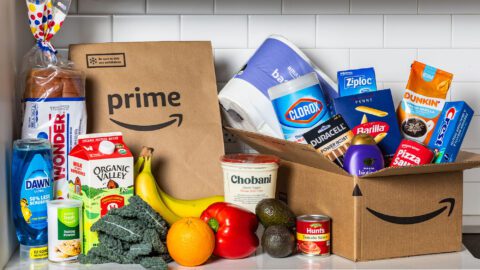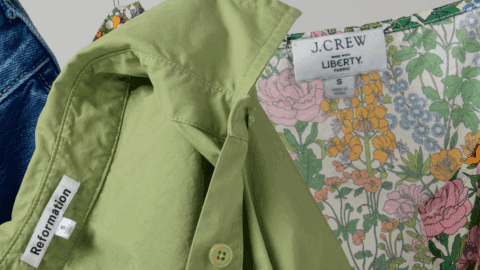There’s no shortage of competition today in the athleisure sector, and like its counterparts, 12-year-old Fabletics is always looking for an edge. The brand’s first distinguishing mark is its membership model, which sets it apart from Lululemon, Vuori, Alo Yoga and the like. But recently Fabletics has been finding another way to stand out — leveraging “social proof” from leading influencers and its own customers.
Social proof is the digital version of, “Don’t believe me, ask [insert authority figure].” At a session during the NRF Big Show, Ken Pilot, Host of The Retail Pilot Podcast, pointed to one of the most common examples — “You know when you’re on a travel website and they say, ‘34 people are looking at this room and there’s one left’ — you’ve been ‘social proofed.’ [It’s about] working with the powers of the crowd to create energy for a call to action.”
Social proof is particularly well-suited to Fabletics, which offers products that are comparable in quality to similar but higher-priced items from other brands. While an in-store shopper can feel the fabric and see the craftsmanship of Fabletics’ athleisurewear, online shoppers (especially first-time purchasers) need validation to trust the product quality without being able to feel it for themselves. Additionally, Fabletics’ membership model provides a wealth of first-party intel, which enables the brand to pinpoint the types of digital messaging most likely to spur a purchase.
Fighting High PDP Bounce Rates
The practice of using social proof may have started with the travel sector, but it’s now firmly rooted in all kinds of online commerce and is particularly useful for retailers as consumers’ online shopping habits evolve.
“In today’s world, customers are going to Google looking for a little black dress. Then they go to the PDP [product detail page], don’t like what they see and they bounce,” explained Marjorie Leonidas, CEO of social proof solution Taggstar. “The PDP effectively becomes the new home page. Whereas in the old days people would go to Brand.com, now people are looking for a specific item and Google is curating their journey and pushing them down to these particular sites and charging for that. [The result is that] when a customer comes to an ecommerce site, [the brand] has very little time to engage with them and convert them.

“The big conundrum of the industry right now is, brands are spending a ton of money on digital ads, people come to their site and then they bounce — bounce rates are like 60% to 80% — so they’re spending a lot of money to get eyeballs that aren’t converting,” Leonidas added in an interview with Retail TouchPoints. “Having this social proof on the PDP [helps brands get] customers to engage with that product, because they can see it’s popular, it’s trending, it’s selling fast.”
For Fabletics, that social proof shows up in a number of distinct ways on its site beyond the tried-and-true customer ratings and reviews. Fabletics is taking it a step further with the integration of customer and influencer videos as well as product-specific FOMO messaging generated by Taggstar across its site.
Fabletics’ Global President Ashley Kechter sat down with Retail TouchPoints to share how the brand is evolving its consumer engagement tactics as it looks to fend off the competition and further its growth goals.
The Challenge: Turning Skeptics into Believers
Fabletics’ membership model is central to the brand’s value prop, which is the same high-quality product as competitors’ but at a lower price point. Members — of which there are now well over 2 million — pay $59.95 a month that can be used toward purchases and gains them access to steep discounts of 20% to 50% off the retail price.
Because the brand was built around this online membership concept, it has entered physical retail later than some of its peers, but now Fabletics is on a rapid brick-and-mortar ramp up. Fabletics still does about 80% of its business online, but over the last five years it also has opened approximately 100 stores and plans to continue that expansion at a rate of about 20 stores a year. “I think we can get to 250 very quickly,” said Kechter.
Membership is promoted in Fabletics’ stores, as it is online, with ample signage showcasing “VIP deals” and the dramatically discounted prices available to members, but ultimately Kechter said winning consumers over is all about the product.
“We offer incredible quality at a price that no one else is competing with right now,” she said. “When people think of Fabletics, and they don’t know the brand or haven’t experienced our product, the assumption is that the discount means it’s not great quality, which is why [physical] retail is so imperative. The reality is we go head-to-head with our competitors in quality — we are sourcing in a lot of the same factories — but we are able to offer a great value because of membership. That’s what membership unlocks — we don’t have to sacrifice on quality to get the cost where we need it. We have massive scale because of the membership model, and that’s recurring revenue.”
The sticking point is getting people to try the product so they can see for themselves, which is where the stores come in. But online, where customers can’t physically experience the product, is more complicated. To solve for that Fabletics has turned to social proof.
How Fabletics is Proving Itself to Digital Consumers
To prove its product quality to online shoppers, Fabletics has dramatically expanded its usage of video testimonials and demonstrations and integrated social proof messaging across its site.

Videos of both influencers and real customers discussing products can now be found almost everywhere on the Fabletics site, from the homepage to the PDPs. “What we’re trying to do is to get our PDP to feel more authentic, with real people wearing our product in their day-to-day life, as well as influencers,” said Kechter. “So that can be images of actual people in our product and videos where you can see someone moving in it, someone working out in it, someone comparing our legging to the [Lululemon] Align legging. We are trying to bring a more authentic, true voice of who we are in the form of video.”
Across the site, shoppers also see a range of messages that direct them toward trending products, helping validate their choices and creating FOMO for products that are selling fast or getting low in stock. These take the form of discreet pop-ups on top of product images as well as messaging in the product details or a customer’s cart saying things like “Hot Item! 193 sold,” “Popular! 15 others are viewing now!” or “#5 Bestseller!”
“There’s lots of flexibility in the messages that we’re putting out there, and that really depends on one, the item, and two, as a membership model, we have a lot of data on our consumers, so we know what our consumer is purchasing,” said Kechter. “We collect a lot of data as part of our membership program, and that then helps us better inform what type of urgency or FOMO messaging we might want to integrate into that PDP.”
This kind of real-time, data-based messaging is based on the principles of Dr. Robert Cialdini, who has studied the power of the crowd to drive behavior. “When you go into a store, you have a shop associate, but online is pretty lonely,” said Leonidas. “Social proof was born out of that, providing people contextual information in real time based on what other people are doing.”
Getting Customers to Click

Taggstar messages draw on real-time and historic customer behavior as well as inventory levels and sales patterns to validate customers’ choices and urge conversion across the online journey.
Fabletics first started working with Taggstar in late 2023, and the company has seen strong results from the beginning of the integration: “We started testing and immediately we saw huge success — we got a 3% lift in conversion. After that we were quick to roll it out much more aggressively,” said Kechter.
Taggstar messaging can now be found across the Fabletics site, and Kechter said she also sees the potential for similar kinds of messaging in the company’s growing roster of stores, especially in the fitting rooms, which are all equipped with interactive iPads. Those iPads can be used by customers to request new sizes or styles while in the fitting room, as well as learn more about membership, so it’s not too much of a stretch (pun intended) to imagine additional messaging that shows products that are top sellers or new styles that have proven popular.
“Our founders are highly interested in new digital technology and marketing,” said Kechter. “From the launch we’ve brought those two things together through a very robust influencer program, aligning with celebrities to help us [gain consumer] trust. As we’ve expanded over the years, we’ve brought in more digital technology to leverage this content, and what’s great about Taggstar is it’s allowed us to lean into what we were already doing with the FOMO messaging, getting customers to click.”















